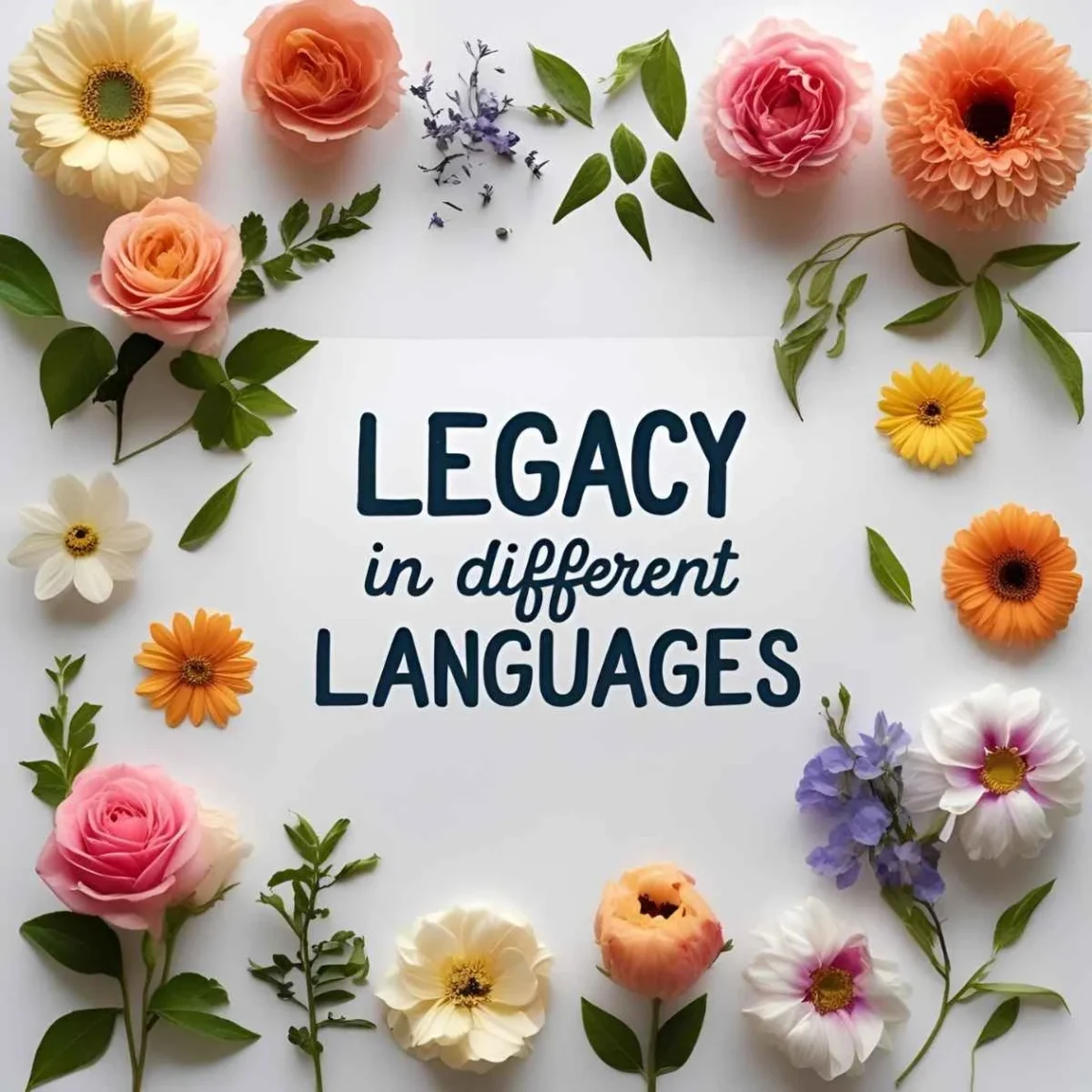Years ago, I sat with my grandmother as she shared stories of her youth, passing down lessons that shaped our family’s values. Her words, woven with wisdom, became her legacy—a gift that lives on in me. Across the world, the concept of “legacy” resonates deeply, capturing what we leave behind for future generations.
Whether it’s a family tradition in a Kenyan village or a cultural artifact in a Japanese temple, “legacy” reflects our shared desire to create something enduring. Let’s explore how this powerful term is expressed in different languages and what it reveals about cultural perspectives on lasting impact.
Reference Table: “Legacy” in Different Languages
| Language | Word/Phrase | Cultural/Linguistic Insight |
|---|---|---|
| French | Héritage | Refers to inheritance, both material and cultural, tied to family pride. |
| Spanish | Legado | Emphasizes contributions passed down, often with historical weight. |
| Italian | Eredità | Denotes inheritance, blending tangible and intangible gifts. |
| German | Vermächtnis | Suggests a deliberate bequest, often tied to personal or societal impact. |
| Mandarin | Yíchǎn (遗产) | Literally “inherited property,” it extends to cultural heritage. |
| Hindi | Virāsat | Evokes a rich inheritance, often tied to family or cultural traditions. |
| Japanese | Isan (遺産) | Refers to inheritance or heritage, with a focus on lasting contributions. |
| Korean | Yusan (유산) | Means “heritage,” often linked to family or national pride. |
| Arabic | Irth (إرث) | Denotes inheritance, deeply tied to familial and religious values. |
| Swahili | Urithi | Refers to heritage, emphasizing communal and ancestral ties. |
| Zulu | Ifa | Means “inheritance,” often linked to spiritual and familial legacy. |
| Yoruba | Ògún | Implies inherited wealth or traditions, tied to lineage. |
| Maori | Taonga tuku iho | Literally “treasures handed down,” emphasizing cultural heirlooms. |
| Hawaiian | Ho‘oilina | Refers to inheritance, often tied to land and family. |
| Cherokee | Adanvdo | Suggests a spiritual or emotional legacy, beyond material wealth. |
European Languages: Enduring Contributions
In Europe, the term for “legacy” often blends personal and cultural significance. For instance, in French, “héritage” refers to both material inheritance and cultural traditions, evoking pride in family history. A Parisian might speak of their family’s “héritage” with reverence for ancestral values. Similarly, Spanish uses “legado,” which carries historical weight, often tied to societal contributions. In Spain, a “legado” might describe an artist’s lasting work. Meanwhile, Italian’s “eredità” combines tangible and intangible inheritance, reflecting Italy’s focus on family legacies. In contrast, German’s “Vermächtnis” suggests a deliberate bequest, like a philosopher’s writings shaping future thought. Thus, European terms highlight both personal and collective impact, from family heirlooms to cultural milestones.
Asian Languages: Heritage and Harmony
Asia’s diverse languages frame “legacy” through cultural and familial lenses. For example, in Mandarin, “yíchǎn” (inherited property) extends to cultural heritage, like preserving ancient traditions in China. In Hindi, “virāsat” evokes a rich inheritance, often tied to family or national pride, as seen in India’s architectural wonders. Additionally, Japanese uses “isan,” focusing on lasting contributions, such as a samurai’s honor passed down through generations. In Korean, “yusan” emphasizes heritage, often linked to national identity, like Korea’s traditional music. Finally, Arabic’s “irth,” used across over 20 countries like Egypt and Saudi Arabia, ties legacy to familial and religious values, reflecting the region’s emphasis on continuity. These terms show Asia’s focus on harmony, blending personal legacies with cultural preservation.
African Languages: Ancestral and Communal Ties
In Africa, “legacy” often centers on community and ancestry. For instance, Swahili, spoken in over 20 countries like Kenya and Uganda, uses “urithi” to denote heritage, emphasizing ancestral ties. A Kenyan elder might pass down “urithi” through oral stories. Similarly, Zulu’s “ifa,” used in South Africa, links legacy to spiritual and familial inheritance. In Yoruba, spoken in Nigeria, “ògún” refers to inherited traditions or wealth, often celebrated in communal rituals. These terms, rooted in collective values, highlight how African cultures view legacy as a shared responsibility, passed down through generations in vibrant gatherings.
Indigenous & Island Languages: Treasures of Tradition
Indigenous and island languages emphasize cultural and emotional legacies. For example, Maori in New Zealand uses “taonga tuku iho” (treasures handed down), referring to cultural heirlooms like carvings or songs. In Hawaiian, “ho‘oilina” ties legacy to land and family, reflecting the islands’ deep connection to nature. Similarly, Cherokee’s “adanvdo” suggests a spiritual legacy, such as wisdom shared through storytelling. In Samoan, phrases like “tusi tupu” (inherited growth) emphasize communal contributions across Pacific cultures. From New Zealand to the Cherokee Nation, these terms highlight enduring traditions, often celebrated in rituals that strengthen community bonds.
Cultural Insights: The Evolution of Legacy
The concept of “legacy” has evolved across civilizations. In ancient Rome, “hereditas” referred to inherited wealth, shaping modern European terms. In Arabic traditions, “irth” gained prominence through Islamic teachings on inheritance, influencing usage across the Middle East. Moreover, African terms like “urithi” reflect oral traditions, preserving history through storytelling. In Asia, the shift from dynastic rule to modern societies influenced terms like “yíchǎn,” now encompassing cultural heritage. These words carry centuries of meaning, from ancient artifacts to modern values, showing how legacy shapes identity across cultures.
Proverbs and Sayings: Wisdom of Legacy
- French: “On ne vit pas pour soi, mais pour ceux qui suivent.” (We live not for ourselves, but for those who follow.) – Emphasizes legacy’s future focus.
- Hindi: “Virāsat dil se dil tak jati hai.” (Legacy travels from heart to heart.) – Highlights emotional inheritance.
- Swahili: “Urithi ni kama mti, hukua kwa vizazi.” (Legacy is like a tree, it grows through generations.) – Reflects growth and continuity.
- Japanese: “Isan wa kokoro ni nokoru.” (A legacy remains in the heart.) – Captures its emotional impact.
- Yoruba: “Ògún ni ìdílé, ìdílé ni ògún.” (Legacy is family, family is legacy.) – Ties legacy to lineage.
FAQs
Why do some terms for “legacy” sound similar?
Shared linguistic roots, like Latin for European languages or Arabic’s influence on Swahili, create similarities through historical exchanges.
What’s the oldest term for “legacy”?
Latin’s “hereditas” (circa 2nd century BCE) is among the earliest, used for inherited wealth and influence.
How do cultures shape the term’s use?
Collectivist cultures (e.g., African, Indigenous) tie legacy to community, while individualistic cultures (e.g., European) focus on personal contributions.
Conclusion
From “legado” in Spain to “taonga tuku iho” in New Zealand, the term for “legacy” weaves a universal story of enduring impact. Each word, whether the ancestral “urithi” in Swahili or the heartfelt “virāsat” in Hindi, reflects cultural values while celebrating our shared desire to leave a mark. Consequently, these terms remind all people that legacy transcends borders, uniting us in a commitment to future generations. How do you say “legacy” in your language, and what legacy do you hope to leave? Share your thoughts below—we’d love to hear your story!




